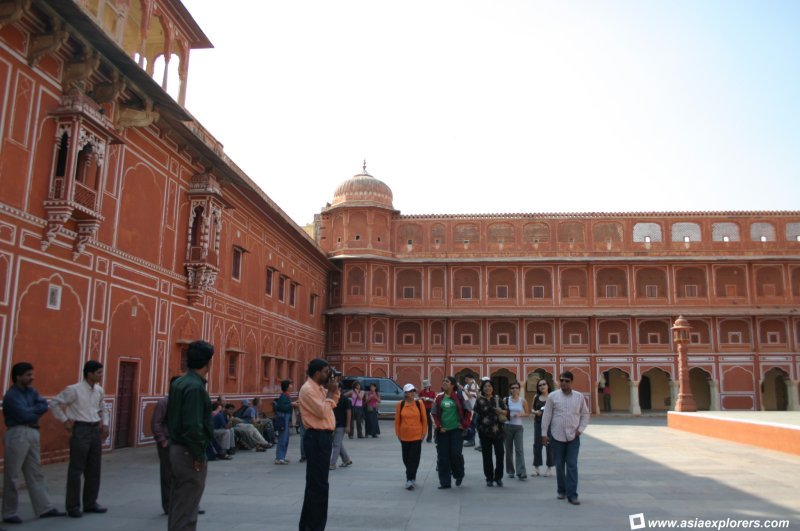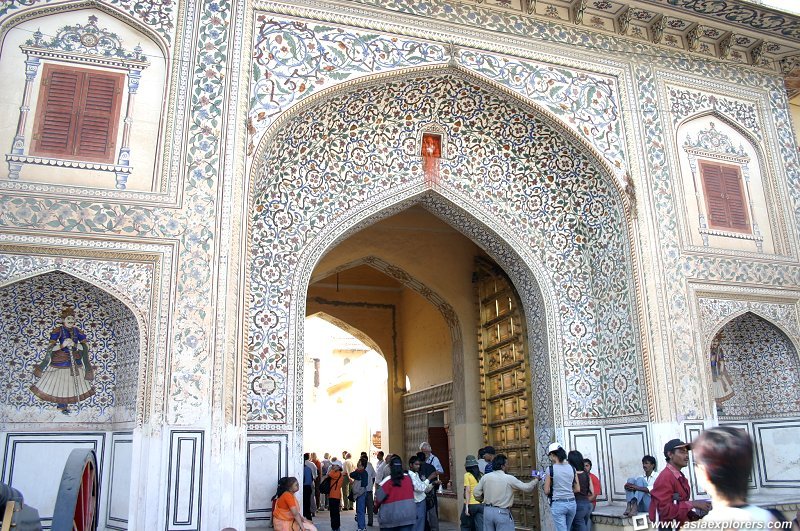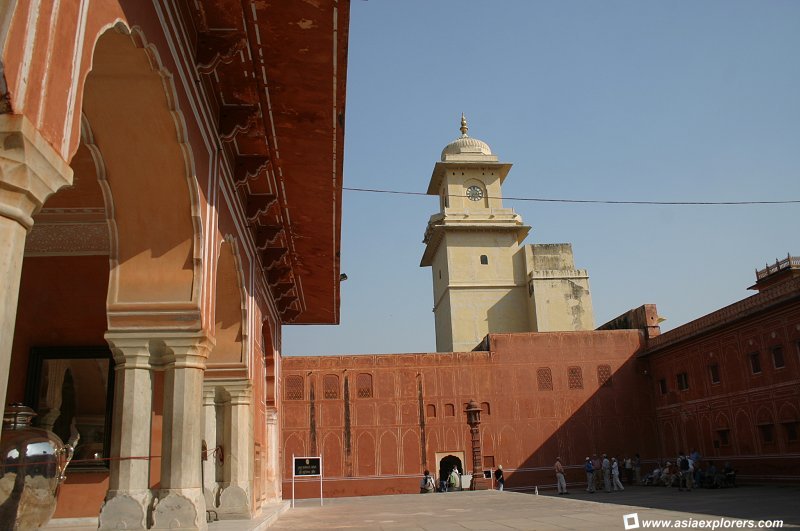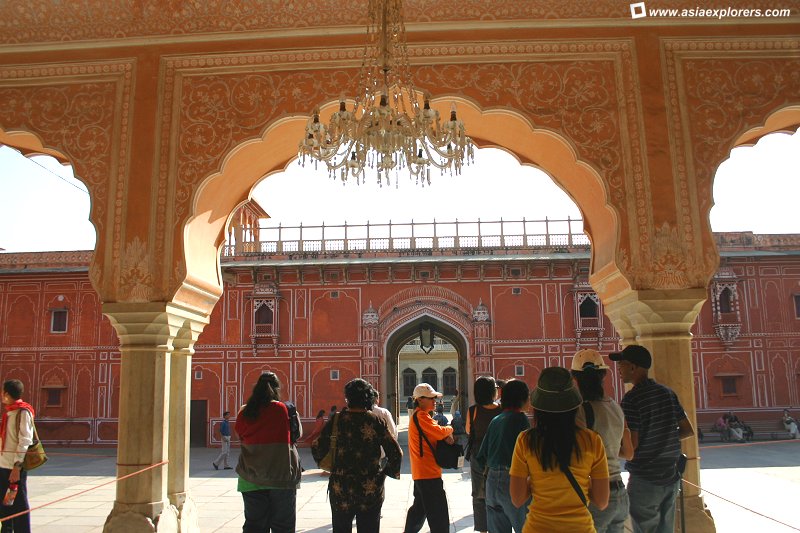 The City Palace, as seen from the direction towards Sileh Khana, the armoury. (6 November, 2004)
The City Palace, as seen from the direction towards Sileh Khana, the armoury. (6 November, 2004)
The City Palace of Jaipur (GPS: 26.92543, 75.82385) was the principle palace in the city of Jaipur, capital of Rajastan, India. Today it houses the City Palace Museum. The City Palace is a sprawling complex that served as the home to Jaipur rulers since the first half of the 18th century.
The buildings within the City Palace complex is a blend of traditional Rajasthan and Mughal architecture. The vast palace complex alone takes up one seventh of the area of the walled city of Jaipur. The City Palace of Jaipur was originally built by Maharaja Jai Singh II of the Kachchawahas (also written Kachhwaha) clan of Rajputs. Since then, subsequent rulers have renovated and extended the complex.
The City Palace complex is divided into a series of courtyards, gardens and buildings. The following are the major buildings within the City Palace.
City Palace Museum of Jaipur is  on the map of Jaipur
on the map of Jaipur
 Entrance into the City Palace of Jaipur. (6 November, 2004)
Entrance into the City Palace of Jaipur. (6 November, 2004)
Mubarak Mahal
In the first courtyard is the Mubarak Mahal, built by Maharaja Madho Singh II in the late 19th century. The Mubarak Mahal, which means Auspicious Palace or Welcome Palace, It was used to receive guests, hence its name. Today the Mubarak Mahal houses the textile section of the Maharaja Sawai Man Singh II Museum.Rajendra Pol
From the Mubarak Mahal, enter through the Rajendra Pol, a magnificent gateway with a marble elephant on each side, to a stately courtyard. Within this courtyard lies the Diwan-I-Khas of Jaipur or Hall of Private Audience.Diwan-I-Khas
The Diwan-I-Khas of Jaipur is an open hall with a double row of columns with scalloped arches. The main attraction here are the two massive silver vessels. These pair of silver vessels are figured in the Guinness Book of World Records as the biggest silver vessels in the world. They were used for carrying water from the holy Ganges for Maharaja Madho Singh II's use during his journey to England.Diwan-I-Aam
Across the paved square lies the Diwan-I-Aam of Jaipur, or Hall of Public Audience, the place where the maharaja comes to meet his subjects. Today it houses Afghan and Persian carpets, miniature paintings, astronomical manuscripts in Persian and Sanskrit. At the other corner is Ridhi Sidhi Pol, a gateway with four small doorways. The City Palace Clock Tower, as seen from Diwan-i-Khas. (6 November, 2004)
The City Palace Clock Tower, as seen from Diwan-i-Khas. (6 November, 2004)
Chandra Mahal
Chandra Mahal is a 7-storey palace on the north-west side of the City Palace Square. The name means Moon Palace. This is the home to the present Maharaja Bhavani Singh, the present Maharaja of Jaipur. If the city flag is raise, it indicates that the Maharaja is in town. If in addition to that, the Imperial flag is also raised, then the maharaja is in residence at the Chandra Mahal.The Chandra Mahal offers a marvellous view of the gardens and the city. Each storey has a distinctive name and is a place of great opulence. The ground and first floor of the Chandra Mahal is part of the Maharaja Sawai Man Singh II Museum. The museum houses an extensive collection of art, carpets, enamelware and 15th century weapons. Among the paintings are miniatures of Rajasthani, Persian and Mughal schools. A section of museum showcases uniforms and costumes of the former Maharajas and Maharanis of Jaipur.
 Members of AsiaExplorers in the Diwan-i-Khas, looking in the direction of the Mubarak Mahal. (6 November, 2004)
Members of AsiaExplorers in the Diwan-i-Khas, looking in the direction of the Mubarak Mahal. (6 November, 2004)
Sukh Nivas or Hall of Rest holds the drawing and dining room of the Maharaja. It is furnished with Mughal miniatures, European silver, glass dining tables and peep holes decorated with gold leafs, for ventilation. On the fourth floor of the Chandra Mahal is the Shobha Nivas or Hall of Beauty. The Shobha Nivas has mirror encrusted walls having exquisite blue tiled dadoes and glittering gold leaf and mica decoration. These and the other upper levels are not open to the public, as they are still occupied by the present Maharaja. The fifth floor is the Chhavi Nivas or Hall of Images. This is where the maharajas retreat during the rainy season. It has a polished floor of eggshell stucco and blue and white painted walls. The sixth floor is graced with mirrored ceiling and stucco floor. It has rows of double columns through which a magnificent view of the surrounding hills is visible. The uppermost storey is called the 'Mukut Mahal' or the Crown Building.
Opposite the Chandra Mahal lies the Badal Mahal while the Govind Devji Temple stands between the Badal Mahal and the Chandra Mahal. An integral part of the City Palace, but standing away from the main complex, is probably the most famous structure of the palace, the Hawa Mahal, or Palace of the Wind.
 Tim with members of AsiaExplorers at the City Palace Museum, Jaipur. (6 November, 2004)
Tim with members of AsiaExplorers at the City Palace Museum, Jaipur. (6 November, 2004)
 Latest updates on Penang Travel Tips
Latest updates on Penang Travel Tips
 Map of Roads in Penang
Map of Roads in Penang
Looking for information on Penang? Use this Map of Roads in Penang to zoom in on information about Penang, brought to you road by road.
Copyright © 2003-2025 Timothy Tye. All Rights Reserved.

 Go Back
Go Back